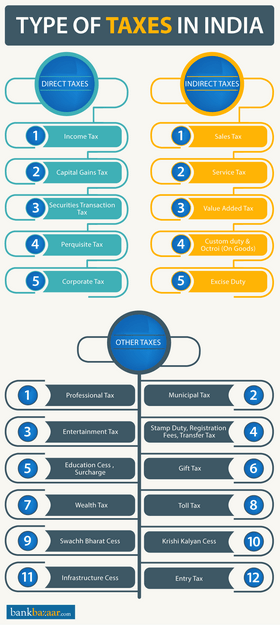ढल जा नमुना
ढल मुल बि॒न नमुनि था थेनि था, सिधा ऐं अणसिधा ढल. विछोटियूं इंदु आहिनि जहिं वाटि सां इहे ढलयूं लागु कयूं वेंदयूं आहिनि. कजहिं तव्हां पारां सिधी रित डि॒ञा आहिनि जि कि डि॒जाईंदड आमदनी ढल, मलिकियत ढल, कोर्पोर्ट ढल वगिराह , जड॒हिं त अण-सिधा ढल , जिअं कि मोल गंढियलु ढल, सेवा ढल, विकरो ढलु वगिराह.
1. सिधी ढलयूं
2. अणसिधा ढलअ
But, besides these two conventional taxes, there are also other taxes that have been brought into effect by the Central Government to serve a particular agenda. ‘Other taxes’ are levied on both direct and indirect taxes such as the recently introduced Swachh Bharat Cess tax, Krishi Kalyan Cess tax, and infrastructure Cess tax among others.
1. सिधा ढल
Direct tax, as stated earlier, are taxes that are paid directly by you. These taxes are levied directly on an entity or an individual and cannot be transferred onto anyone else. One of the bodies that overlooks these direct taxes is the Central Board of Direct Taxes (CBDT) which is a part of the Department of Revenue. It has, to help it with its duties, the support of various acts that govern various aspects of direct taxes.
इन मां के कानुन:
· आमदनी ढल कानुन:
इहा पिणि जाणि वेंदी आहे 1961 जे आई टी कानुन तोर ऐं नियम जी पक कंदी आहे जो कि भारत जे कमाई ढल खे तरतीब कंदो आहे. आमदनी, जहिं ते इहो कानुन ढलाऐ थो, सो कहिं बि मुंढ मां अचि थो सघे जिअं की वेपार, घर या मलिकियत जी मालिकी, पघार या सेडहायप तां फाईदो वगिराह. ही इहो कानुन आहे जो पक कंदो आहे केतरी ढल फाईदो पीक्स डिजाजिट ते मिलिंदी या केजिरो जीवन बिमे जी किस्त ठहिंदी. इहो पिणि उहो कोनुन आहे जो पक कंदो आहे आहे त तव्हां जे आमदनी जो केतिरो तव्हां सेडहायप सां बचाऐ सघिंदा ऐं आमदनी ढल जे केडहे स्तर लागु थिंदो.
· मलिकियत ढल कानुन:
The Wealth Tax Act was enacted in 1951 and is responsible for the taxation related to the net wealth of an individual, a company or a Hindu Unified Family. The simplest calculation of wealth tax was that if the net wealth exceeded Rs. 30 lakhs, then 1% of the amount that exceeded Rs. 30 lakhs was payable as tax. It was abolished in the budget announced in 2015. It has since been replaced with a surcharge of 12% on individuals that earn more than Rs. 1 crore per annum. It is also applicable to companies that have a revenue of over Rs. 10 crores per annum. The new guidelines drastically increased the amount the government would collect in taxes as opposed the amount they would collect through the wealth tax.
· Gआई ऐफ टी ढल कानुन:
सोखडी ढल कानुन 1958 में वजुद में आयो ऐं जाणायो त जेकर को शख्स सोखडी, रोक या किमती शयूं हासिल करे सोखडी तोर, हिक ढल जो भूगतान करणो पवंदो उन सोखडीअ ते. ढल ऐडहयूंनि सोखडयूं ते 30% ताईं लागु कयो वेंदो आङे पर इहो 1998 में रदि कयो वयो हो. शुरुआत में जेकरि का सोखडी पई डि॒ञी वञे, ऐं इहे जडहिं मलिकियत, ग॒ह या शेअर वगिराह हुजिनि , इहे ढलाईता हुंदा हवा. नऐं नियमनि जे मोजिबु अकहिं जे भातीयुंनि पारां सोखडी जिअं कि भाउर, भेनरुं, माईट, जोणसि, मासीयूं या चाचनि पारां सथसि ढल नाहे लगिंदो. इन हद साईं जे सोखडयूं जो तव्हां इलाकाणी अख्तियार खे डि॒दा त इहे हिन ढल खां बा॒हार थिंदयूं. हिंअर किअं ढल कमु कंदी आहे जे इअं त जेकरि को, छुट हासिल कयलु अकाईं खां सवाई, तव्हां खे सोखडीअ में कजहि डे॒ थो जहिं जो मोल रुपया 50,000 आहे, पोई समुरी सोखडी जी राशी ढलाईती थिंदी.
· खर्चु ढल कानुन:
हिउ हिकु कानुन आहे जो कि 1987 में वजूद में आयो ऐं इहो तव्हां जे हिक शख्स जे रुप में होटल या रेसटुरेंट में हासिल कयसु वेवायूं ते कयलु खर्च सा वासतो थो रखे. इहो समुरे भारत में लागु आहे ,वाई जम्मु ऐं कशमीर जे. इहो पधिरो थो करे त खर्च ते वसुली कई वेंदी हिन कानुन हेटि जेकरि इहो रुपया 3 खां वधिक थिंदा, 000 होटलनि लाई ऐं समुरी वसुली जो कि रेस्टुरेंट में खर्च थिया हुजिनि.
· वयाज ढल कानुन:
1974 जो वयाज ढल कानुन खास खसुसी हालितुंन में वयाज जी कमाई ते मथोुं ढल सां लागापो रखिंदो आहे. कानु जे विछाडी जे फेरबदल में इहो पधिरो कयो वयो हो त इहो कानुन नाहे मार्च 2000 खां पोई कमायल वयाज ते लागु नाहे थिंदो.
हेटि मिसाल था डि॒जिनि समुरे धार धार नमुने जे सिधे ढल जा:

सिधी ढल जा मिसाल
उते कजहि सिधा ढल आङिनि जो कि तव्हां भरिंदा आहियो
a) आमदनी ढल:
हिउ सभिनि खां वझी जातलु ऐं घटि समिझयलु ढल आहे. इहा हिक ढल आहे जो कि मडही वेंदी आहे तव्हां जे कमाईअ ते माली साल में. हिते जाम वधिक पासा आङिनि कमाई ढल खे जिअं कि ढल स्तर, ढलाईती कमाई, मुंद ते ढल कटाई (टी डी ऐस), डलाईते कमाई मंझ घटाई वगिराह. ढल लागु थिंदी आहे बि॒नहिनि शख्सअनि तोडे कम्पनीयूंनि ते. शखसनि लाई, जा ढल खेनि बुगतान थी करणी पवे सा दारुमदार ती रखे उन ढल जे भाङे में जहिं में हो किरन था. हिउ ब्रेकेट या स्तर पक कंदो आहे भूगतान कंदड ढल जो जोकि आधारित आहे कथ कंदड जे सालाने कमाई ऐं इहा बो॒डी ढल खां 30% ढल थी ती सघे वधीक कमाई गिरोह लाई.
सरकार पक कई आहे जुदा जुदा ढल जी तख्ता धार धार शख्सनी जे गिरोह लाई , मसलनि रिवाजी ढल डिं॒दड, वडे॒उमर जा नागरिक (माण्हुं जहि जी उमर 60 खां 80 आहे ऐं तमाम घणे उमर जा (माण्हुं जहिं जी उमर 80 कां मथे आहे).
b) सरमाऐ फाईदो ढल:
This is a tax that is payable whenever you receive a sizable amount of money. It could be from an investment or from the sale of a property. It is usually of two types, short term capital gains from investments held for less than 36 months and long term capital gains from investments held for longer than 36 months. The tax applicable for each is also very different since the tax on short term gains is calculated based in the income bracket that you fall in and the tax on long term gains is 20%. The interest thing about this tax is that the gain doesn’t always have to be in the form of money. It could also be an exchange in kind in which case the value of the exchange will be considered for taxation.
c) तहफूज डे॒तीलेती ढल:
इन में का बि गु॒जायप नाहे जे जेकरि तव्हां खे जा॒णि आहे त किअं स्टाक शेअर बाजार ऐं तहपूज में वेपार कजे, तव्हां जाम पैसा कमाऐ था सघो. हिउ पिणि कमाई जो हिकु मुंढ आहे पर खेसि पंहिजी ढल आहे जहिंखे तहफूज डे॒तीलेती ढल चईजे थो . किअं हिउ ढल मडही वेंदीआहे शेअर जे किमत खे गंढण बैदि. हिन जो मसलबु इहो आहे त हर वक्त तव्हां शेअर खरिदो या विकणो, तव्हां खे ढल जो भुगतान करणो पवंदो. समुरी वेपारित तङफूजनि खे बारतीय स्टाक ऐंकसेंचेंज मथसि इहा ढल खेनि गंढियलु आहे.
घ) लापो ढल:
Perquisites are all the perks or privileges that employers may extend to employees. These privileges may include a house provided by the company or a car for your use, given to you by the company. These perks are not just limited to big compensation like cars and houses, they can even include things like compensation for fuel or phone bills. How this tax is levied is by figuring out how that perk has been acquired by the company or used by the employee. In the case of cars, it may be so that a car provided by the company and used for both personal and official purposes is eligible for tax whereas a car used only for official purposes is not.
e) कार्पोरेट ढल:
Corporate tax is the income tax that is paid by companies from the revenue they earn. This tax also comes with a slab of its own that decides how much tax the company has to pay. For example a domestic company, which has a revenue of less than Rs. 1 crore per annum, won’t have to pay this tax but one that has a revenue of more than Rs. 1 crore per annum will have to pay this tax. It is also referred to as a surcharge and is different for different revenue brackets. It is also different for international companies where the corporate tax may be 41.2% if the company has a revenue of less than Rs. 10 million and so on.
There are four different types of corporate tax. They are:
· घटि में घटि बि॒वाटी ढलु:
घटि में घटि बे॒धर जी ढल, या ऐम ऐ टी, बुनियादी तोर हिक वाटि आहे आमदनी ढल विभाग जो कमपनीयूंनि खे घटि में घटि ढल भूगतान करण जो , जो हि हिंअर 18.5% आहे. हिन नमुने जो ढल असर हेटि आंदो वयोआमदनी ढल कोनुन जे विभाग 115 जे ऐ जे देबा॒चो थिअण सां. बहरआल, कम्पनीयूं जो कि मुंझयलु आहिनि आडावत ऐं भिजली बिबागन में से ऐम ऐ टी जे भूगतान खां आझो आहिनि.
हेकरि जड॒हिं का कम्पनी ऐम ऐ टी जो भूगतान करे थी, हो भुगतान अग॒ते वधाऐ थी ऐं तरतीब-निपिटाऐ (बंदोबस्तय) करे रिवाजी ढल जी इंदल पंज लासनि जे अर्से लाई कजहिं शर्तुनि जे हेटि.
· झालर फाईदो ढलु:
वाधो सहुलितय ढल, या ऐफ बी टी, हिकु ढल हो जो कि लागु कयो वेंदो हो लग भग हर वाधो फाईदे ते जो हिकु मालिक पंहिंजे मुलाजि मेसर कंदो हो. हिन ढल में , जाम पहलुंनि खे ध्यानु डि॒ञो वेंदो आहे. इन मंझ के आहिनि:
i) मुलाजिम जो सैर ते खर्चु (ऐल टी ऐ), मुलाजिम खुशहाली, पिहाईश ऐं विंदुरु.
ii) को बि रिवाजी आमदफरद या आमदफरद सां लागापो रखिंदड खर्चु जो कि मालिज पारां मेसर थो कराईजे.
iii) मालिक जी पती हिक साबित कयलु फारुग राशी.
iv) मुलाजिम स्टाक विकल्प रिथा (ई ऐस ओ पी अ).
ऐफ बी टी शुरु कई वई हुई भारत सरकार जे निगरानी में अप्रेल 1, 2005 खां. बहरआल, ढल पोई वञी 2009 में रदि कयो वयो तहिं महल जे माली वजिर प्रणब मुखर्जी पारां 2009 मर्कजी बजेट इजलास महल.
· वनढणी वर्छायप ढल:
पाईदो विर्छायप ढल पधरी कई वई हुई 2007 जे मर्कजी बजेट जे पिछाईअ ते. It is basically a tax levied on companies based on the dividend they pay to their investors. This tax is applicable on the gross or net income an investor receives from their investment. हिंअर, डी डी टी जा अघ 15% ते विठा आहिनि.
· बैंक रोक डे॒तिलेती ढल:
बैंक रोक डे॒तीलेती ढल अञा हिक धारो तरिको हो ढल जो जा भारत सरकार पारां तयागी वई आहे. हिन नमुने जी ढल लागु हुई 2005-2009 ताईं, जेसिताईं न ऐफ ऐम प्रणब मुखर्जी ढल खे खारिज कई. हिउ ढल सलाहि थो डि॒ऐ त हर बैंक डेतीलेती (जमा या निकाली) ते ढल मडही वेंदी 0.1% जे अघ ते.
2. अणसिधी ढल:
By definition, indirect taxes are those taxes that are levied on goods or services. They differ from direct taxes because they are not levied on a person who pays them directly to the government, they are instead levied on products and are collected by an intermediary, the person selling the product. The most common examples of indirect tax Indirect tax can be VAT (Value Added Tax), Taxes on Imported Goods, Sales Tax, etc. These taxes are levied by adding them to the price of the service or product which tends to push the cost of the product up.
अण-सिधे ढल जा मिसाल:
हिउ आहिनि कजहि आम अण-सिधा ढल जो तव्हां भरींदा आहियो.
a) Sales Tax:
जिअं नालो ड॒सु पई डि॒ञो, विकरो ढल उहा ढल आहे जा पदार्थ जे विकरे ते मडही वेंदी आहे. हिउ पदार्थ कजहि ती थो सघे जो भारत में पैदा या आयात कयो वयो ऐं इन हद ताई जे मेसर करयलु सेवा ड॒ई थो सघे. हिउ ढल मडही वेंदी आहे पदार्थ जे विकिणिंदड मथां जो कि इन खे खरिदकंदड ते फेरबदल कंदो आहे उन खसुसी पदाईथ नसबत पदार्थ मथां विकरो ढल जो मोल गंढे. हिन ढल जी महदुदगी इहा आहे त इहा खसुसी पदार्थ ते मडी वेंदी आहे जहिं जो मतलबु जे जेकर इहो पदार्थ बि॒हर पिकरो वयो त इन ते बि॒हर ढल नाहे लागु थिंदो.
बुनियादी तोर, मुल्क में समुरा प्रदेश संदुनि पहिंजो विकरो ढल मञिंदा आहिनि ऐं मडहिंदा आहिनि पंहिजे नमुने सां. इन खां ,वाई, के थोडा राज्य पिणि मडहिंदा आहिनि धार भूगतान जिअं की उपत ढल, खरिदी ढल, कमअ डे॒तीलेती ढल ऐं इअं कजहि. इहो पिणि सबब आहे जे थो विकरो ढल जुदा जुजा सरकारन लाई सभनि खां वडो॒ कर कठो करिंदड थिंदो आहे. वरी, हिउ ढल मडहो वेंदो आङे बि॒नहिनि जे हेटि केंद्र ऐं राज्य कोनुन में.
b) Service Tax:
Like sales tax is added to the price of goods sold in India, so is service tax added to services provided in India. In the reading of the budget 2015, it was announced that the service tax will be raised from 12.36% to 14%. It is not applicable on goods but on companies that provide services and is collected every month or once every quarter based on how the services are provided. If the establishment is an individual service provider then the service tax is paid only once the customer pays the bills however, for companies the service tax is payable the moment the invoice is raised, irrespective of the customer paying the bill.
हिक अहम शई जा याद रखण जेडही आहे आहे सा आहे छो त रेस्टुरेंट में सेवा खादे, वेटर ऐं जाई ग॒डि॒यलु आहे , इहो ओखो थी पवंदो आहे त सेवा ढल जी मात्रा छा ती थी सघे. इंन मुंझारे खे सोरण लाई, इहो ऐलान कयो वयो आहे त रेस्टुरेंटनि में सेवा ढल मडही वेंदी जा कुल बील जी 40% थिंदी.
- जी ऐस टी - समान ऐं सेवा ढल:
The Goods and Services Tax (GST) is the largest reform in India’s indirect tax structure since the market started opening up about 25 years ago. The GST is a consumption-based tax, as it is applicable where consumption takes place. The GST is levied on value-added goods and services at each stage of consumption in the supply chain. The GST payable on the procurement of goods and services can be set off against the GST payable on the supply of goods and services, the merchant will pay the applicable GST rate but can claim it back through the tax credit mechanism.
c) Value Added Tax:
वी ऐ टी, पिणि वाणिजी ढल त सुञाती वेंदी आहे सा लागु नाहे उन शयूंनि ते जो कि बूडी पर्खयलु आ (मसलनि. खादो ऐं जरुरी दवा) या उहे जो कि निर्यात हे हेठि किरिन थयूं. इहो ढल मडहयो वेंदो आहे सप्लाई चेन जे समुरे हालितुनि में, ठाहिंदज खां, सौदारर, वरहाईंदड थिंदे पिछाडीअ जे वापिराईंदड ताईं.
The value added tax is a tax that is levied at the discretion of the state government and not all states implemented it when it was first announced. The tax is levied on various goods sold in the state and the amount of the tax is decided by the state itself. For example in Gujrat the government split all the good into various categories called schedules. There are 3 schedules and each schedule has its own VAT percentage. For Schedule 3 the VAT is 1%, for schedule 2 the VAT is 5% and so on. Goods that have not been classified into any category have a VAT of 15%.
d) Custom duty & Octroi:
When you purchase anything that needs to be imported from another country, a charge is applied on it and that is the customs duty. It applies to all the products that come in via land, sea or air. Even if you bring in products bought in another country to India, a customs duty can be levied on it. The purpose of the customs duty is to ensure that all the goods entering the country are taxed and paid for. Just as customs duty ensures that goods for other countries are taxed, octroi is meant to ensure that goods crossing state borders within India are taxed appropriately. It is levied by the state government and functions in much the same way as customs duty does.
e) Excise Duty:
हिउ उहा ढल आहे जा मडही वेंदी आहे भारत में संमुरे सामान पैदाकंदड या ठहिंदड मथां. इहो कस्टम टयूटी खां धार आहे छो त इहो लागप रुगो॒ उन शयूंनि ते थिंदो आहे जो हिक बारत में पैदा थी हुजिनि ऐं इन खे सेंट्रल वेलु ऐडेड टेक्स या सेनवेट पिणि कोठियो वेंदो आहे. हिउ ढल कठो कयो वेंदो आहे सरकार पारां सामान जी ठाहणईंदडनि खां. इहा पिणि उगारे थी सघिजे इन इकाईयूंनि खां जो कि हासिल था कनि ठहयलु सामान ऐं माण्हनि खे रोजगार पई डिं॒दा आहिनि सामान खे ठाहिंदड खां पाणवटि आमदफरद करण लाई.
केंद्र सरकार पारां जोडायलु सेंट्रल ऐकसाईस नियम इहो ड॒सु डि॒दो आहे त हिर शख्स जो पैदाकंदड आहे या ठाहिंदड को बि 'ऐकसाईकृत सामान ' या जो कि ऐडहा सामान गोदानमि में जमा थो करे, खेनि ढल जो भूगतान करणो पवंदो उन सामान ते जिअं कि. हिन नियम हेटि को बि ऐकसाईस वारो सामान, तहिं ते कर जो भुगतान लागु आहे, खेसि मोकल डि॒ञि वेंदी आमदफरद जी कर जे भूगतान खां सवाई कहिं बि जाई तो, भले इहे पैदाकयलु हुजिनि ऐं ठातलु.













